rise of mobile technology Assignment PDF
VerifiedAdded on 2021/07/30
|10
|2820
|53
AI Summary
Contribute Materials
Your contribution can guide someone’s learning journey. Share your
documents today.
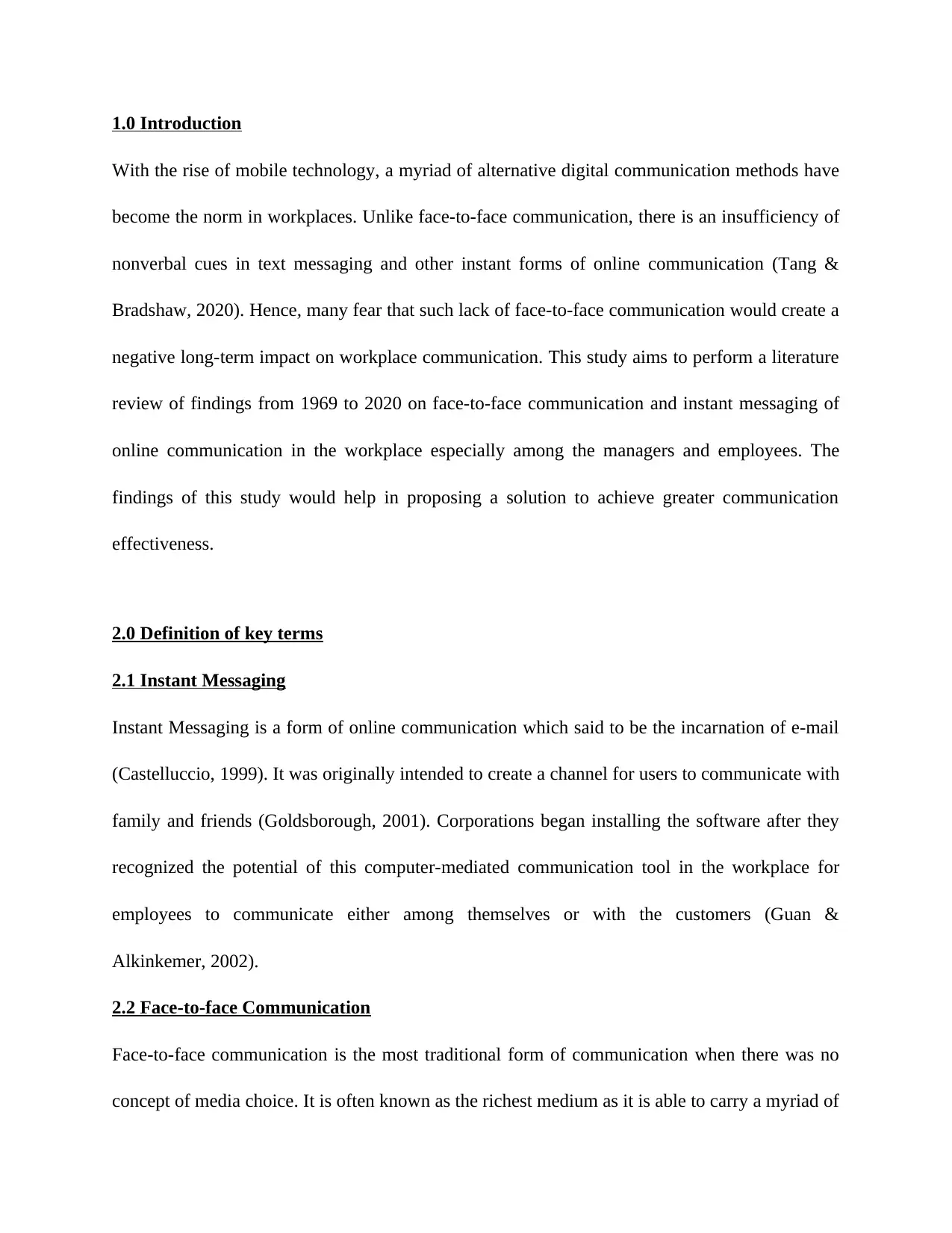
1.0 Introduction
With the rise of mobile technology, a myriad of alternative digital communication methods have
become the norm in workplaces. Unlike face-to-face communication, there is an insufficiency of
nonverbal cues in text messaging and other instant forms of online communication (Tang &
Bradshaw, 2020). Hence, many fear that such lack of face-to-face communication would create a
negative long-term impact on workplace communication. This study aims to perform a literature
review of findings from 1969 to 2020 on face-to-face communication and instant messaging of
online communication in the workplace especially among the managers and employees. The
findings of this study would help in proposing a solution to achieve greater communication
effectiveness.
2.0 Definition of key terms
2.1 Instant Messaging
Instant Messaging is a form of online communication which said to be the incarnation of e-mail
(Castelluccio, 1999). It was originally intended to create a channel for users to communicate with
family and friends (Goldsborough, 2001). Corporations began installing the software after they
recognized the potential of this computer-mediated communication tool in the workplace for
employees to communicate either among themselves or with the customers (Guan &
Alkinkemer, 2002).
2.2 Face-to-face Communication
Face-to-face communication is the most traditional form of communication when there was no
concept of media choice. It is often known as the richest medium as it is able to carry a myriad of
With the rise of mobile technology, a myriad of alternative digital communication methods have
become the norm in workplaces. Unlike face-to-face communication, there is an insufficiency of
nonverbal cues in text messaging and other instant forms of online communication (Tang &
Bradshaw, 2020). Hence, many fear that such lack of face-to-face communication would create a
negative long-term impact on workplace communication. This study aims to perform a literature
review of findings from 1969 to 2020 on face-to-face communication and instant messaging of
online communication in the workplace especially among the managers and employees. The
findings of this study would help in proposing a solution to achieve greater communication
effectiveness.
2.0 Definition of key terms
2.1 Instant Messaging
Instant Messaging is a form of online communication which said to be the incarnation of e-mail
(Castelluccio, 1999). It was originally intended to create a channel for users to communicate with
family and friends (Goldsborough, 2001). Corporations began installing the software after they
recognized the potential of this computer-mediated communication tool in the workplace for
employees to communicate either among themselves or with the customers (Guan &
Alkinkemer, 2002).
2.2 Face-to-face Communication
Face-to-face communication is the most traditional form of communication when there was no
concept of media choice. It is often known as the richest medium as it is able to carry a myriad of
Secure Best Marks with AI Grader
Need help grading? Try our AI Grader for instant feedback on your assignments.
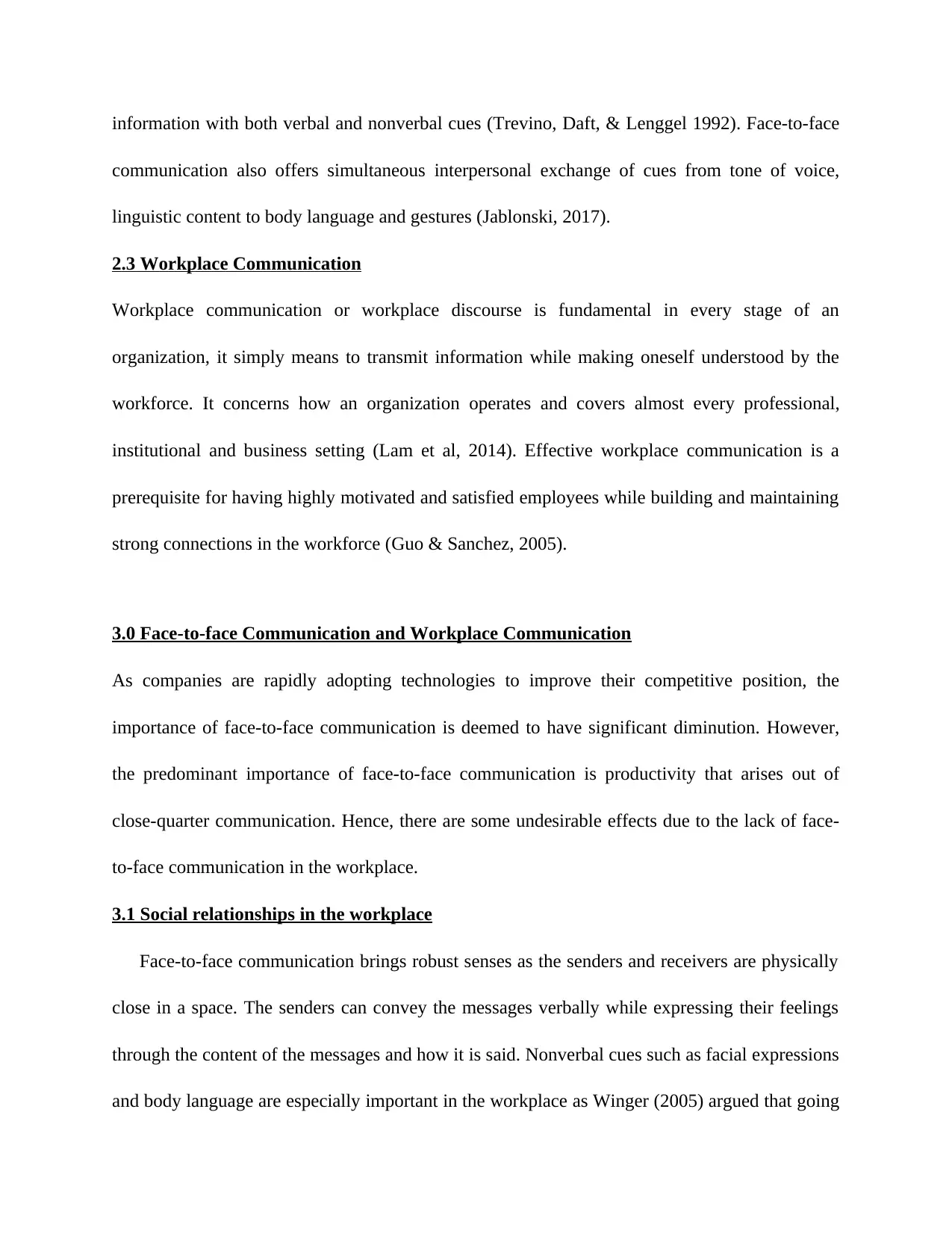
information with both verbal and nonverbal cues (Trevino, Daft, & Lenggel 1992). Face-to-face
communication also offers simultaneous interpersonal exchange of cues from tone of voice,
linguistic content to body language and gestures (Jablonski, 2017).
2.3 Workplace Communication
Workplace communication or workplace discourse is fundamental in every stage of an
organization, it simply means to transmit information while making oneself understood by the
workforce. It concerns how an organization operates and covers almost every professional,
institutional and business setting (Lam et al, 2014). Effective workplace communication is a
prerequisite for having highly motivated and satisfied employees while building and maintaining
strong connections in the workforce (Guo & Sanchez, 2005).
3.0 Face-to-face Communication and Workplace Communication
As companies are rapidly adopting technologies to improve their competitive position, the
importance of face-to-face communication is deemed to have significant diminution. However,
the predominant importance of face-to-face communication is productivity that arises out of
close-quarter communication. Hence, there are some undesirable effects due to the lack of face-
to-face communication in the workplace.
3.1 Social relationships in the workplace
Face-to-face communication brings robust senses as the senders and receivers are physically
close in a space. The senders can convey the messages verbally while expressing their feelings
through the content of the messages and how it is said. Nonverbal cues such as facial expressions
and body language are especially important in the workplace as Winger (2005) argued that going
communication also offers simultaneous interpersonal exchange of cues from tone of voice,
linguistic content to body language and gestures (Jablonski, 2017).
2.3 Workplace Communication
Workplace communication or workplace discourse is fundamental in every stage of an
organization, it simply means to transmit information while making oneself understood by the
workforce. It concerns how an organization operates and covers almost every professional,
institutional and business setting (Lam et al, 2014). Effective workplace communication is a
prerequisite for having highly motivated and satisfied employees while building and maintaining
strong connections in the workforce (Guo & Sanchez, 2005).
3.0 Face-to-face Communication and Workplace Communication
As companies are rapidly adopting technologies to improve their competitive position, the
importance of face-to-face communication is deemed to have significant diminution. However,
the predominant importance of face-to-face communication is productivity that arises out of
close-quarter communication. Hence, there are some undesirable effects due to the lack of face-
to-face communication in the workplace.
3.1 Social relationships in the workplace
Face-to-face communication brings robust senses as the senders and receivers are physically
close in a space. The senders can convey the messages verbally while expressing their feelings
through the content of the messages and how it is said. Nonverbal cues such as facial expressions
and body language are especially important in the workplace as Winger (2005) argued that going
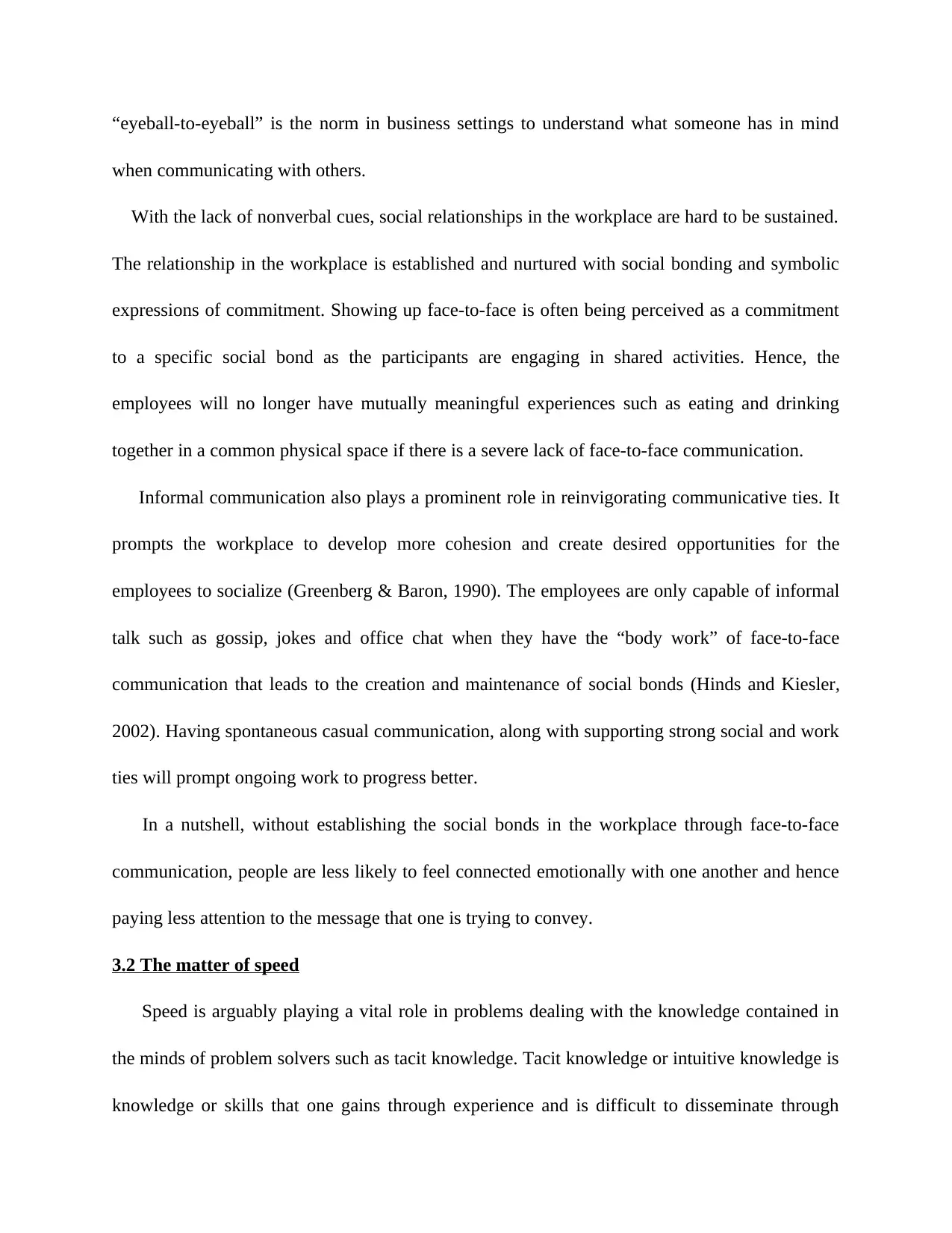
“eyeball-to-eyeball” is the norm in business settings to understand what someone has in mind
when communicating with others.
With the lack of nonverbal cues, social relationships in the workplace are hard to be sustained.
The relationship in the workplace is established and nurtured with social bonding and symbolic
expressions of commitment. Showing up face-to-face is often being perceived as a commitment
to a specific social bond as the participants are engaging in shared activities. Hence, the
employees will no longer have mutually meaningful experiences such as eating and drinking
together in a common physical space if there is a severe lack of face-to-face communication.
Informal communication also plays a prominent role in reinvigorating communicative ties. It
prompts the workplace to develop more cohesion and create desired opportunities for the
employees to socialize (Greenberg & Baron, 1990). The employees are only capable of informal
talk such as gossip, jokes and office chat when they have the “body work” of face-to-face
communication that leads to the creation and maintenance of social bonds (Hinds and Kiesler,
2002). Having spontaneous casual communication, along with supporting strong social and work
ties will prompt ongoing work to progress better.
In a nutshell, without establishing the social bonds in the workplace through face-to-face
communication, people are less likely to feel connected emotionally with one another and hence
paying less attention to the message that one is trying to convey.
3.2 The matter of speed
Speed is arguably playing a vital role in problems dealing with the knowledge contained in
the minds of problem solvers such as tacit knowledge. Tacit knowledge or intuitive knowledge is
knowledge or skills that one gains through experience and is difficult to disseminate through
when communicating with others.
With the lack of nonverbal cues, social relationships in the workplace are hard to be sustained.
The relationship in the workplace is established and nurtured with social bonding and symbolic
expressions of commitment. Showing up face-to-face is often being perceived as a commitment
to a specific social bond as the participants are engaging in shared activities. Hence, the
employees will no longer have mutually meaningful experiences such as eating and drinking
together in a common physical space if there is a severe lack of face-to-face communication.
Informal communication also plays a prominent role in reinvigorating communicative ties. It
prompts the workplace to develop more cohesion and create desired opportunities for the
employees to socialize (Greenberg & Baron, 1990). The employees are only capable of informal
talk such as gossip, jokes and office chat when they have the “body work” of face-to-face
communication that leads to the creation and maintenance of social bonds (Hinds and Kiesler,
2002). Having spontaneous casual communication, along with supporting strong social and work
ties will prompt ongoing work to progress better.
In a nutshell, without establishing the social bonds in the workplace through face-to-face
communication, people are less likely to feel connected emotionally with one another and hence
paying less attention to the message that one is trying to convey.
3.2 The matter of speed
Speed is arguably playing a vital role in problems dealing with the knowledge contained in
the minds of problem solvers such as tacit knowledge. Tacit knowledge or intuitive knowledge is
knowledge or skills that one gains through experience and is difficult to disseminate through
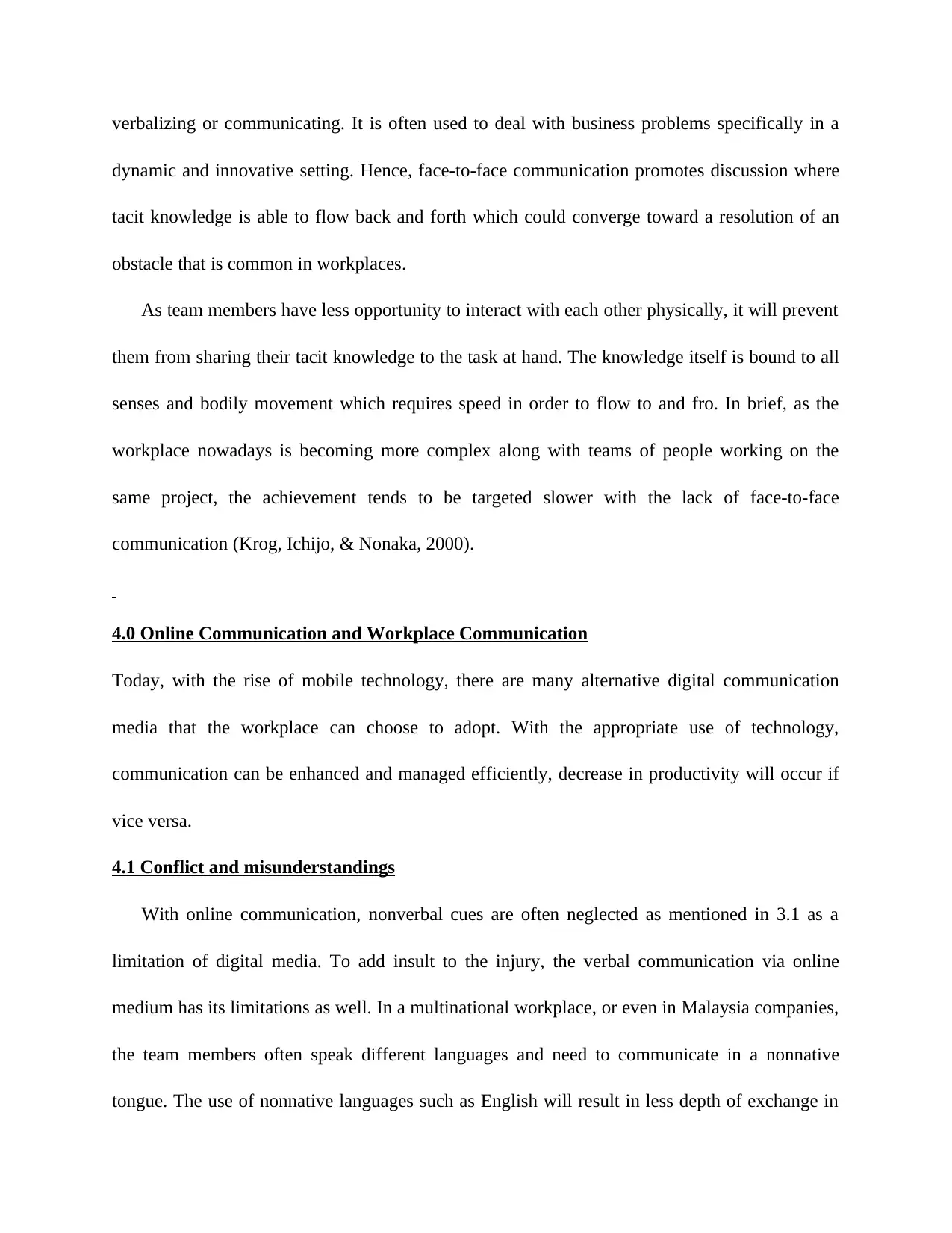
verbalizing or communicating. It is often used to deal with business problems specifically in a
dynamic and innovative setting. Hence, face-to-face communication promotes discussion where
tacit knowledge is able to flow back and forth which could converge toward a resolution of an
obstacle that is common in workplaces.
As team members have less opportunity to interact with each other physically, it will prevent
them from sharing their tacit knowledge to the task at hand. The knowledge itself is bound to all
senses and bodily movement which requires speed in order to flow to and fro. In brief, as the
workplace nowadays is becoming more complex along with teams of people working on the
same project, the achievement tends to be targeted slower with the lack of face-to-face
communication (Krog, Ichijo, & Nonaka, 2000).
4.0 Online Communication and Workplace Communication
Today, with the rise of mobile technology, there are many alternative digital communication
media that the workplace can choose to adopt. With the appropriate use of technology,
communication can be enhanced and managed efficiently, decrease in productivity will occur if
vice versa.
4.1 Conflict and misunderstandings
With online communication, nonverbal cues are often neglected as mentioned in 3.1 as a
limitation of digital media. To add insult to the injury, the verbal communication via online
medium has its limitations as well. In a multinational workplace, or even in Malaysia companies,
the team members often speak different languages and need to communicate in a nonnative
tongue. The use of nonnative languages such as English will result in less depth of exchange in
dynamic and innovative setting. Hence, face-to-face communication promotes discussion where
tacit knowledge is able to flow back and forth which could converge toward a resolution of an
obstacle that is common in workplaces.
As team members have less opportunity to interact with each other physically, it will prevent
them from sharing their tacit knowledge to the task at hand. The knowledge itself is bound to all
senses and bodily movement which requires speed in order to flow to and fro. In brief, as the
workplace nowadays is becoming more complex along with teams of people working on the
same project, the achievement tends to be targeted slower with the lack of face-to-face
communication (Krog, Ichijo, & Nonaka, 2000).
4.0 Online Communication and Workplace Communication
Today, with the rise of mobile technology, there are many alternative digital communication
media that the workplace can choose to adopt. With the appropriate use of technology,
communication can be enhanced and managed efficiently, decrease in productivity will occur if
vice versa.
4.1 Conflict and misunderstandings
With online communication, nonverbal cues are often neglected as mentioned in 3.1 as a
limitation of digital media. To add insult to the injury, the verbal communication via online
medium has its limitations as well. In a multinational workplace, or even in Malaysia companies,
the team members often speak different languages and need to communicate in a nonnative
tongue. The use of nonnative languages such as English will result in less depth of exchange in
Secure Best Marks with AI Grader
Need help grading? Try our AI Grader for instant feedback on your assignments.

terms of knowledge, which further increase the psychological distance and fears of misuse and
misinterpretation of knowledge (Gibson & Cohen, 2004).
The lack of contextual cues will lead to a greater amount of conflict in online groups as the
team members might face difficulty in deciphering the message behind the words. It is hard to
provide a clear explanation on screen without the nonverbal cues. In addition, online
communication undoubtedly prevents the team members from having eye contact. Arguments
and contradictions are easier to occur without having to look at the people in the eyes.
Communication might get muddled at times during the process of online communication and it
will be a challenge to interpret humorous intentions in an online environment which could
mislead the receivers to face sarcasm (Mallen et al, 2003).
4.2 Information overload
Online communication is ubiquitous not only in the workplace but also in everyday life. By
staying connected online every minute, we inevitably get to receive messages from anyone at
any time. The flow of information in the workplace today has become much saturated that leads
to the constant bombardment of information (Kupritz & Cowell, 2010). Information overload
happens when the information received exceeds the individuals’ ability to handle it (Farhoomand
& Drury, 2002).
Information overload could create interruption on the flow and continuity of an individual’s
work which brings that work to a temporary halt. Not only do interruptions divert the employees’
attention away from their primary task, but on top of that, the employees discontinue the project
that they are working on and move to another task (Wajcman & Rose, 2001). When the
employees are addressing the interruptions, they will have less time to work on the primary task
misinterpretation of knowledge (Gibson & Cohen, 2004).
The lack of contextual cues will lead to a greater amount of conflict in online groups as the
team members might face difficulty in deciphering the message behind the words. It is hard to
provide a clear explanation on screen without the nonverbal cues. In addition, online
communication undoubtedly prevents the team members from having eye contact. Arguments
and contradictions are easier to occur without having to look at the people in the eyes.
Communication might get muddled at times during the process of online communication and it
will be a challenge to interpret humorous intentions in an online environment which could
mislead the receivers to face sarcasm (Mallen et al, 2003).
4.2 Information overload
Online communication is ubiquitous not only in the workplace but also in everyday life. By
staying connected online every minute, we inevitably get to receive messages from anyone at
any time. The flow of information in the workplace today has become much saturated that leads
to the constant bombardment of information (Kupritz & Cowell, 2010). Information overload
happens when the information received exceeds the individuals’ ability to handle it (Farhoomand
& Drury, 2002).
Information overload could create interruption on the flow and continuity of an individual’s
work which brings that work to a temporary halt. Not only do interruptions divert the employees’
attention away from their primary task, but on top of that, the employees discontinue the project
that they are working on and move to another task (Wajcman & Rose, 2001). When the
employees are addressing the interruptions, they will have less time to work on the primary task
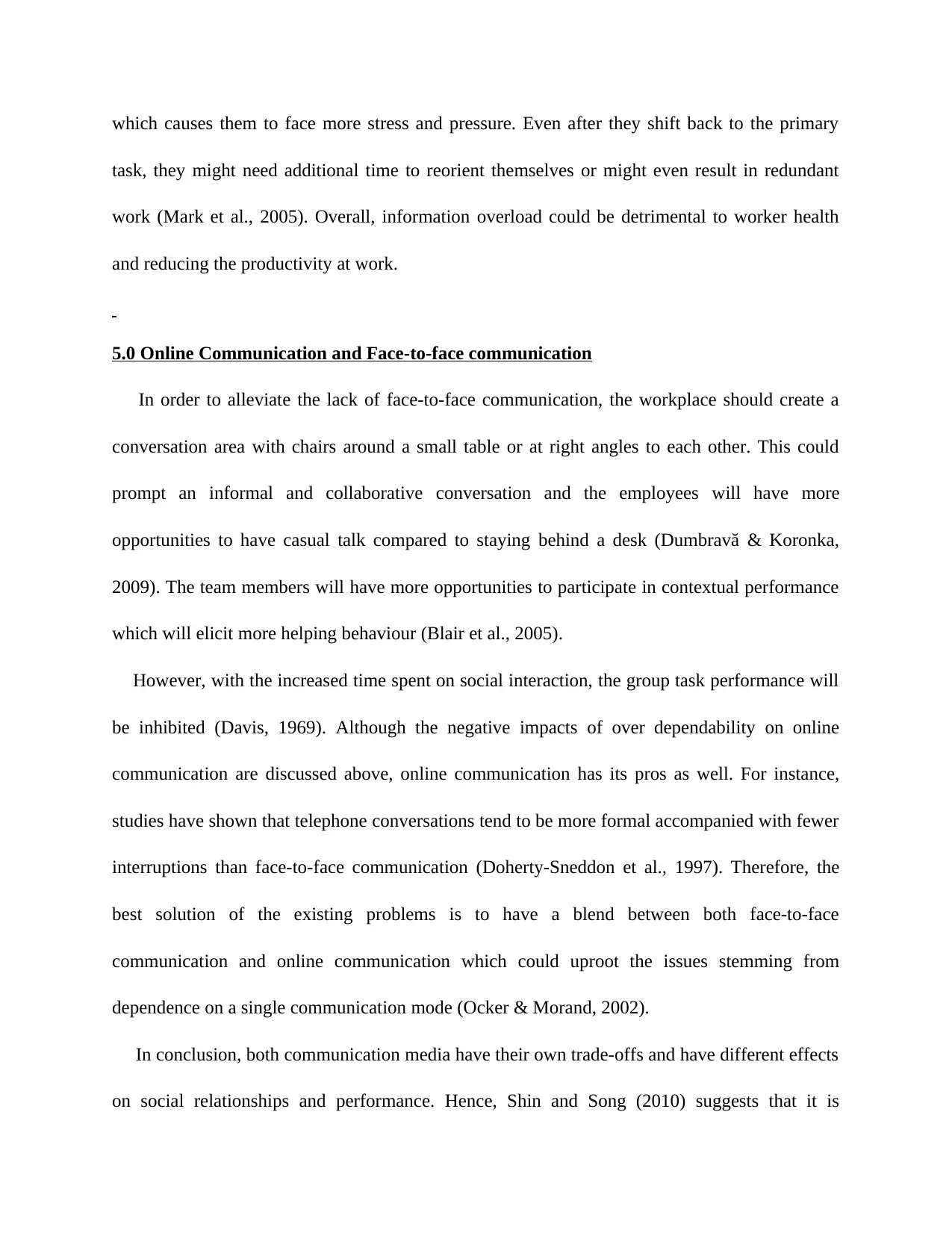
which causes them to face more stress and pressure. Even after they shift back to the primary
task, they might need additional time to reorient themselves or might even result in redundant
work (Mark et al., 2005). Overall, information overload could be detrimental to worker health
and reducing the productivity at work.
5.0 Online Communication and Face-to-face communication
In order to alleviate the lack of face-to-face communication, the workplace should create a
conversation area with chairs around a small table or at right angles to each other. This could
prompt an informal and collaborative conversation and the employees will have more
opportunities to have casual talk compared to staying behind a desk (Dumbravă & Koronka,
2009). The team members will have more opportunities to participate in contextual performance
which will elicit more helping behaviour (Blair et al., 2005).
However, with the increased time spent on social interaction, the group task performance will
be inhibited (Davis, 1969). Although the negative impacts of over dependability on online
communication are discussed above, online communication has its pros as well. For instance,
studies have shown that telephone conversations tend to be more formal accompanied with fewer
interruptions than face-to-face communication (Doherty-Sneddon et al., 1997). Therefore, the
best solution of the existing problems is to have a blend between both face-to-face
communication and online communication which could uproot the issues stemming from
dependence on a single communication mode (Ocker & Morand, 2002).
In conclusion, both communication media have their own trade-offs and have different effects
on social relationships and performance. Hence, Shin and Song (2010) suggests that it is
task, they might need additional time to reorient themselves or might even result in redundant
work (Mark et al., 2005). Overall, information overload could be detrimental to worker health
and reducing the productivity at work.
5.0 Online Communication and Face-to-face communication
In order to alleviate the lack of face-to-face communication, the workplace should create a
conversation area with chairs around a small table or at right angles to each other. This could
prompt an informal and collaborative conversation and the employees will have more
opportunities to have casual talk compared to staying behind a desk (Dumbravă & Koronka,
2009). The team members will have more opportunities to participate in contextual performance
which will elicit more helping behaviour (Blair et al., 2005).
However, with the increased time spent on social interaction, the group task performance will
be inhibited (Davis, 1969). Although the negative impacts of over dependability on online
communication are discussed above, online communication has its pros as well. For instance,
studies have shown that telephone conversations tend to be more formal accompanied with fewer
interruptions than face-to-face communication (Doherty-Sneddon et al., 1997). Therefore, the
best solution of the existing problems is to have a blend between both face-to-face
communication and online communication which could uproot the issues stemming from
dependence on a single communication mode (Ocker & Morand, 2002).
In conclusion, both communication media have their own trade-offs and have different effects
on social relationships and performance. Hence, Shin and Song (2010) suggests that it is
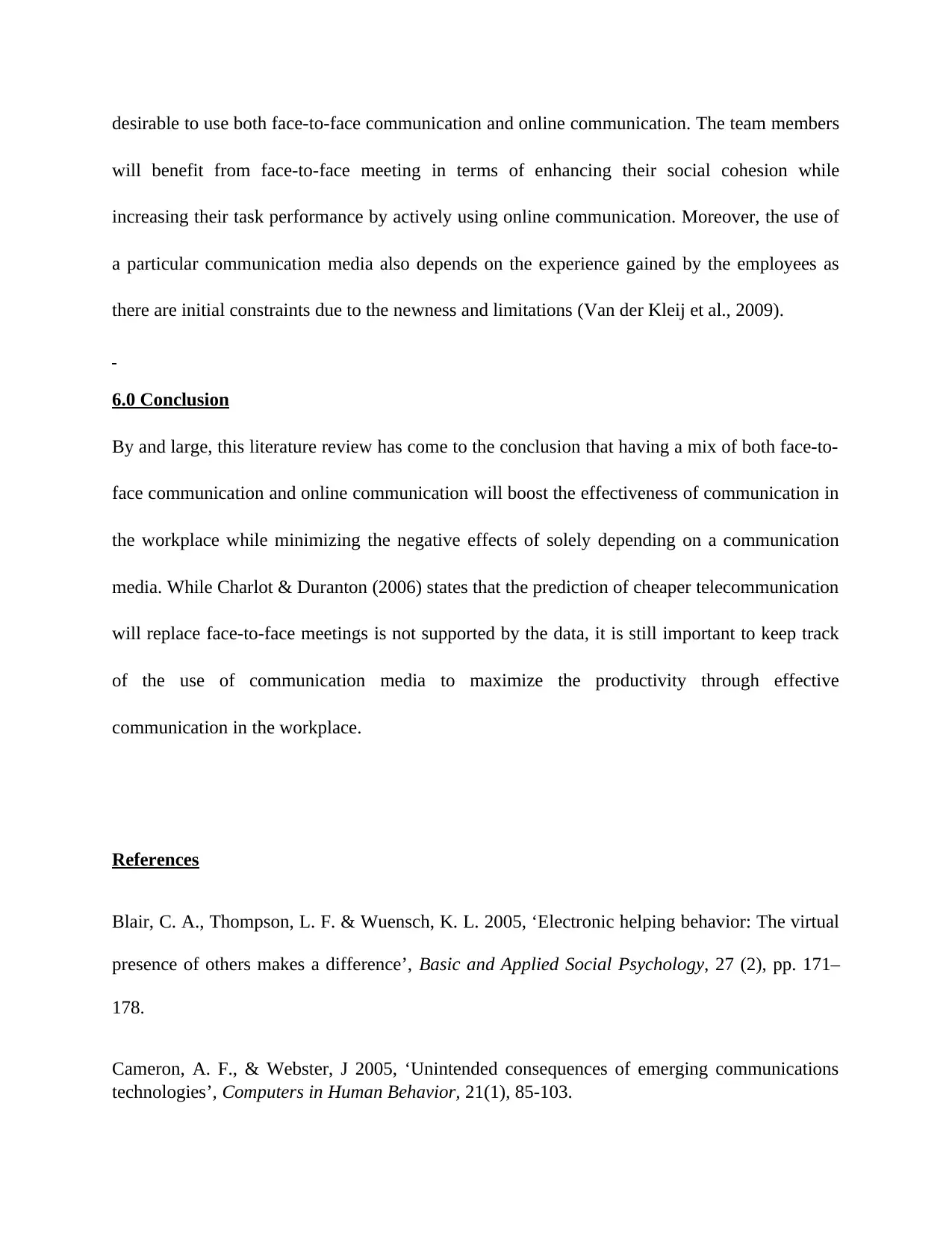
desirable to use both face-to-face communication and online communication. The team members
will benefit from face-to-face meeting in terms of enhancing their social cohesion while
increasing their task performance by actively using online communication. Moreover, the use of
a particular communication media also depends on the experience gained by the employees as
there are initial constraints due to the newness and limitations (Van der Kleij et al., 2009).
6.0 Conclusion
By and large, this literature review has come to the conclusion that having a mix of both face-to-
face communication and online communication will boost the effectiveness of communication in
the workplace while minimizing the negative effects of solely depending on a communication
media. While Charlot & Duranton (2006) states that the prediction of cheaper telecommunication
will replace face-to-face meetings is not supported by the data, it is still important to keep track
of the use of communication media to maximize the productivity through effective
communication in the workplace.
References
Blair, C. A., Thompson, L. F. & Wuensch, K. L. 2005, ‘Electronic helping behavior: The virtual
presence of others makes a difference’, Basic and Applied Social Psychology, 27 (2), pp. 171–
178.
Cameron, A. F., & Webster, J 2005, ‘Unintended consequences of emerging communications
technologies’, Computers in Human Behavior, 21(1), 85-103.
will benefit from face-to-face meeting in terms of enhancing their social cohesion while
increasing their task performance by actively using online communication. Moreover, the use of
a particular communication media also depends on the experience gained by the employees as
there are initial constraints due to the newness and limitations (Van der Kleij et al., 2009).
6.0 Conclusion
By and large, this literature review has come to the conclusion that having a mix of both face-to-
face communication and online communication will boost the effectiveness of communication in
the workplace while minimizing the negative effects of solely depending on a communication
media. While Charlot & Duranton (2006) states that the prediction of cheaper telecommunication
will replace face-to-face meetings is not supported by the data, it is still important to keep track
of the use of communication media to maximize the productivity through effective
communication in the workplace.
References
Blair, C. A., Thompson, L. F. & Wuensch, K. L. 2005, ‘Electronic helping behavior: The virtual
presence of others makes a difference’, Basic and Applied Social Psychology, 27 (2), pp. 171–
178.
Cameron, A. F., & Webster, J 2005, ‘Unintended consequences of emerging communications
technologies’, Computers in Human Behavior, 21(1), 85-103.
Paraphrase This Document
Need a fresh take? Get an instant paraphrase of this document with our AI Paraphraser
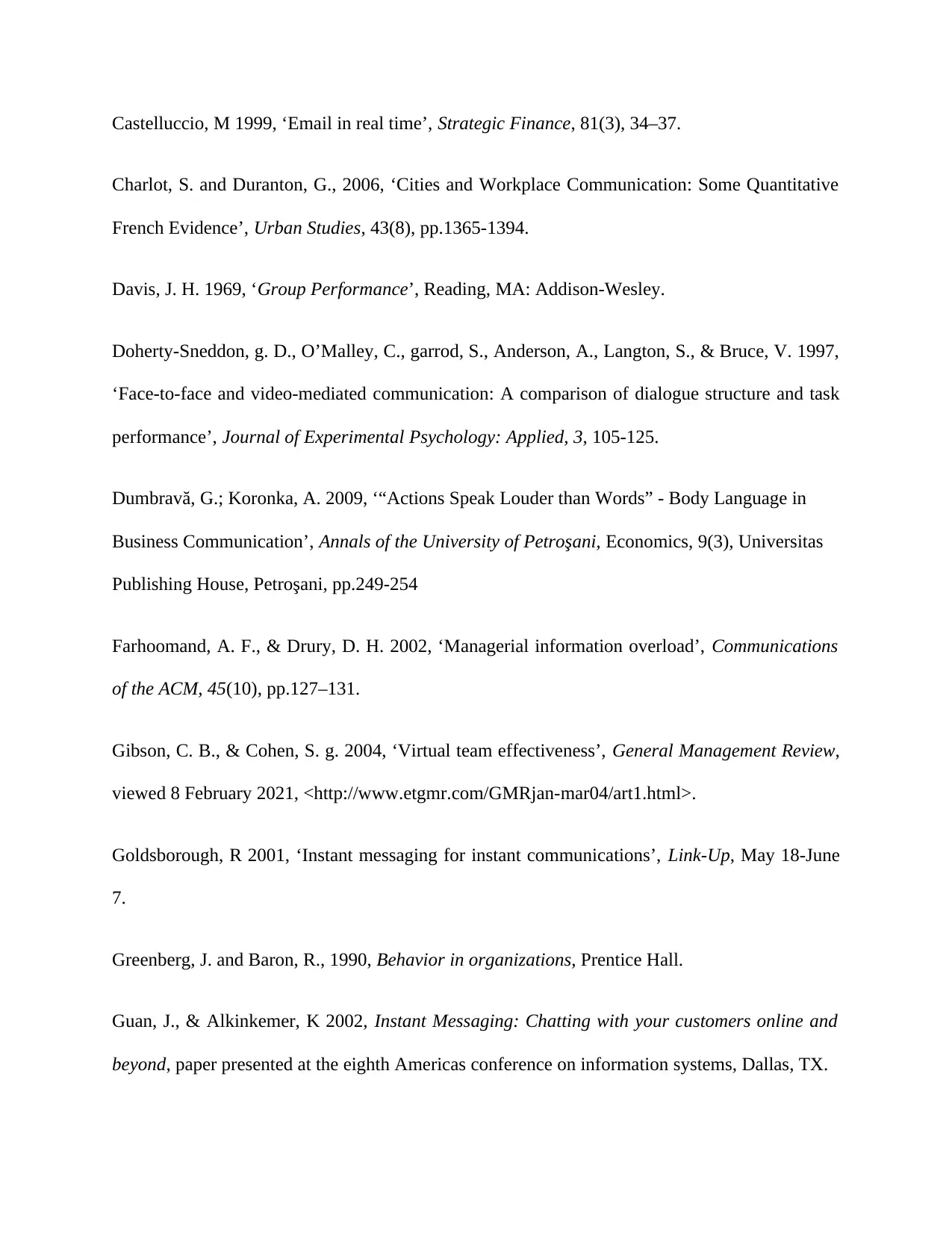
Castelluccio, M 1999, ‘Email in real time’, Strategic Finance, 81(3), 34–37.
Charlot, S. and Duranton, G., 2006, ‘Cities and Workplace Communication: Some Quantitative
French Evidence’, Urban Studies, 43(8), pp.1365-1394.
Davis, J. H. 1969, ‘Group Performance’, Reading, MA: Addison-Wesley.
Doherty-Sneddon, g. D., O’Malley, C., garrod, S., Anderson, A., Langton, S., & Bruce, V. 1997,
‘Face-to-face and video-mediated communication: A comparison of dialogue structure and task
performance’, Journal of Experimental Psychology: Applied, 3, 105-125.
Dumbravă, G.; Koronka, A. 2009, ‘“Actions Speak Louder than Words” - Body Language in
Business Communication’, Annals of the University of Petroşani, Economics, 9(3), Universitas
Publishing House, Petroşani, pp.249-254
Farhoomand, A. F., & Drury, D. H. 2002, ‘Managerial information overload’, Communications
of the ACM, 45(10), pp.127–131.
Gibson, C. B., & Cohen, S. g. 2004, ‘Virtual team effectiveness’, General Management Review,
viewed 8 February 2021, <http://www.etgmr.com/GMRjan-mar04/art1.html>.
Goldsborough, R 2001, ‘Instant messaging for instant communications’, Link-Up, May 18-June
7.
Greenberg, J. and Baron, R., 1990, Behavior in organizations, Prentice Hall.
Guan, J., & Alkinkemer, K 2002, Instant Messaging: Chatting with your customers online and
beyond, paper presented at the eighth Americas conference on information systems, Dallas, TX.
Charlot, S. and Duranton, G., 2006, ‘Cities and Workplace Communication: Some Quantitative
French Evidence’, Urban Studies, 43(8), pp.1365-1394.
Davis, J. H. 1969, ‘Group Performance’, Reading, MA: Addison-Wesley.
Doherty-Sneddon, g. D., O’Malley, C., garrod, S., Anderson, A., Langton, S., & Bruce, V. 1997,
‘Face-to-face and video-mediated communication: A comparison of dialogue structure and task
performance’, Journal of Experimental Psychology: Applied, 3, 105-125.
Dumbravă, G.; Koronka, A. 2009, ‘“Actions Speak Louder than Words” - Body Language in
Business Communication’, Annals of the University of Petroşani, Economics, 9(3), Universitas
Publishing House, Petroşani, pp.249-254
Farhoomand, A. F., & Drury, D. H. 2002, ‘Managerial information overload’, Communications
of the ACM, 45(10), pp.127–131.
Gibson, C. B., & Cohen, S. g. 2004, ‘Virtual team effectiveness’, General Management Review,
viewed 8 February 2021, <http://www.etgmr.com/GMRjan-mar04/art1.html>.
Goldsborough, R 2001, ‘Instant messaging for instant communications’, Link-Up, May 18-June
7.
Greenberg, J. and Baron, R., 1990, Behavior in organizations, Prentice Hall.
Guan, J., & Alkinkemer, K 2002, Instant Messaging: Chatting with your customers online and
beyond, paper presented at the eighth Americas conference on information systems, Dallas, TX.
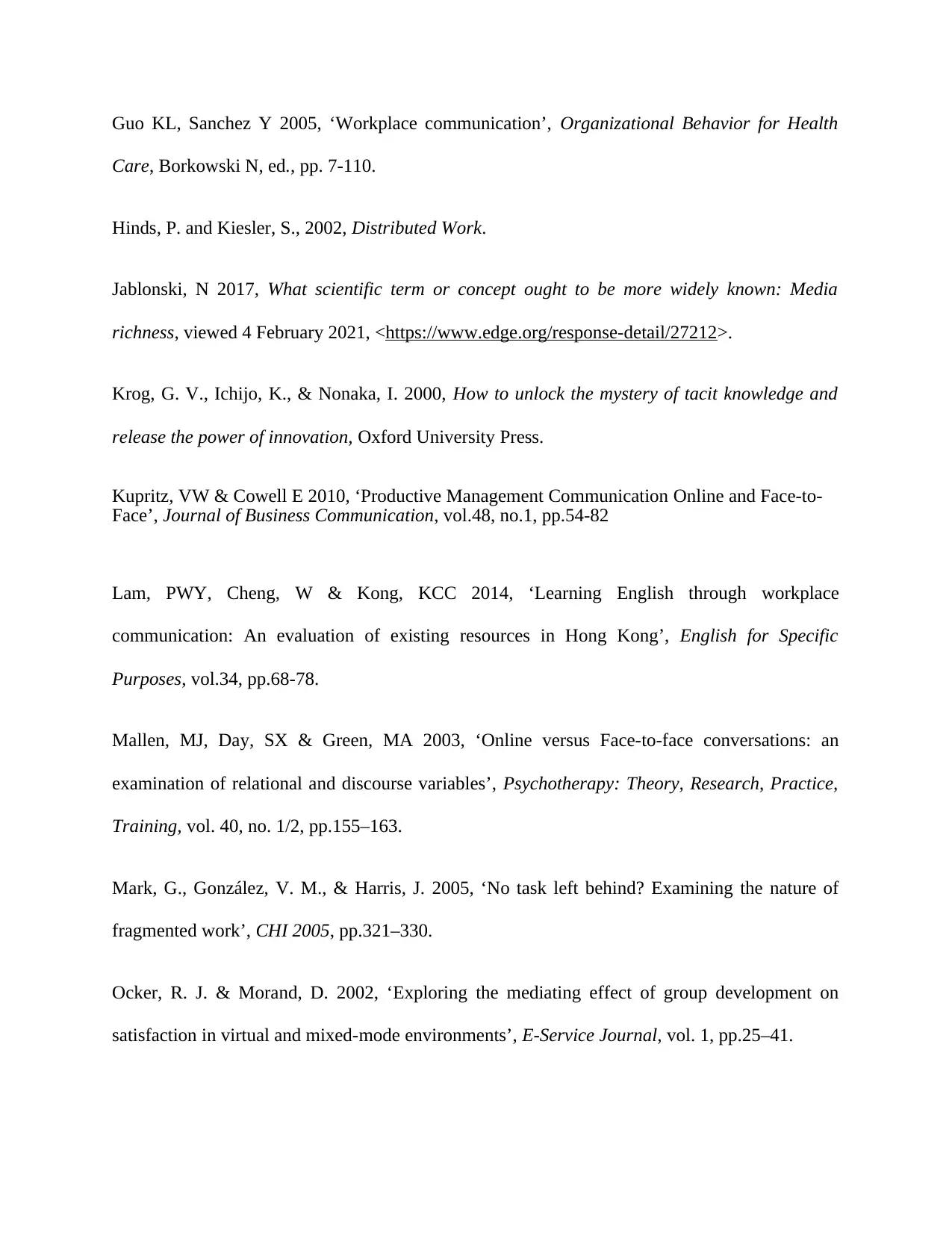
Guo KL, Sanchez Y 2005, ‘Workplace communication’, Organizational Behavior for Health
Care, Borkowski N, ed., pp. 7-110.
Hinds, P. and Kiesler, S., 2002, Distributed Work.
Jablonski, N 2017, What scientific term or concept ought to be more widely known: Media
richness, viewed 4 February 2021, <https://www.edge.org/response-detail/27212>.
Krog, G. V., Ichijo, K., & Nonaka, I. 2000, How to unlock the mystery of tacit knowledge and
release the power of innovation, Oxford University Press.
Kupritz, VW & Cowell E 2010, ‘Productive Management Communication Online and Face-to-
Face’, Journal of Business Communication, vol.48, no.1, pp.54-82
Lam, PWY, Cheng, W & Kong, KCC 2014, ‘Learning English through workplace
communication: An evaluation of existing resources in Hong Kong’, English for Specific
Purposes, vol.34, pp.68-78.
Mallen, MJ, Day, SX & Green, MA 2003, ‘Online versus Face-to-face conversations: an
examination of relational and discourse variables’, Psychotherapy: Theory, Research, Practice,
Training, vol. 40, no. 1/2, pp.155–163.
Mark, G., González, V. M., & Harris, J. 2005, ‘No task left behind? Examining the nature of
fragmented work’, CHI 2005, pp.321–330.
Ocker, R. J. & Morand, D. 2002, ‘Exploring the mediating effect of group development on
satisfaction in virtual and mixed-mode environments’, E-Service Journal, vol. 1, pp.25–41.
Care, Borkowski N, ed., pp. 7-110.
Hinds, P. and Kiesler, S., 2002, Distributed Work.
Jablonski, N 2017, What scientific term or concept ought to be more widely known: Media
richness, viewed 4 February 2021, <https://www.edge.org/response-detail/27212>.
Krog, G. V., Ichijo, K., & Nonaka, I. 2000, How to unlock the mystery of tacit knowledge and
release the power of innovation, Oxford University Press.
Kupritz, VW & Cowell E 2010, ‘Productive Management Communication Online and Face-to-
Face’, Journal of Business Communication, vol.48, no.1, pp.54-82
Lam, PWY, Cheng, W & Kong, KCC 2014, ‘Learning English through workplace
communication: An evaluation of existing resources in Hong Kong’, English for Specific
Purposes, vol.34, pp.68-78.
Mallen, MJ, Day, SX & Green, MA 2003, ‘Online versus Face-to-face conversations: an
examination of relational and discourse variables’, Psychotherapy: Theory, Research, Practice,
Training, vol. 40, no. 1/2, pp.155–163.
Mark, G., González, V. M., & Harris, J. 2005, ‘No task left behind? Examining the nature of
fragmented work’, CHI 2005, pp.321–330.
Ocker, R. J. & Morand, D. 2002, ‘Exploring the mediating effect of group development on
satisfaction in virtual and mixed-mode environments’, E-Service Journal, vol. 1, pp.25–41.

Shin, Y. and Song, K., 2010, ‘Role of face-to-face and computer-mediated communication time
in the cohesion and performance of mixed-mode groups’, Asian Journal of Social Psychology,
14(2), pp.126-139.
Tang, C. M. and Bradshaw, A 2020, ‘Instant messaging or face-to-face? How choice of
communication medium affects team collaboration environments’. E-Learning and Digital
Media, 17(2), pp.111–130.
Trevino, L. K., Daft, R. L., & Lengel, R. H 1992, ‘Understanding manager’s media choices’,
Organizations and communications technologies, J. Fulk, & C. W. Steinfield (Eds.), CA7 Sage
Publications.
Van der Kleij, R., Maarten Schraagen, J., Werkhoven, P. and De Dreu, C., 2009, ‘How
Conversations Change Over Time in Face-to-Face and Video-Mediated Communication’, Small
Group Research, 40(4), pp.355-381.
Wajcman, J., & Rose, E. 2011, ‘Constant connectivity: Rethinking interruptions at work’,
Organization Science, vol. 32, pp.941–961.
Winger, A., 2005, ‘Face-to-face communication: Is it really necessary in a digitizing world?’,
Business Horizons, 48(3), pp.247-253.
in the cohesion and performance of mixed-mode groups’, Asian Journal of Social Psychology,
14(2), pp.126-139.
Tang, C. M. and Bradshaw, A 2020, ‘Instant messaging or face-to-face? How choice of
communication medium affects team collaboration environments’. E-Learning and Digital
Media, 17(2), pp.111–130.
Trevino, L. K., Daft, R. L., & Lengel, R. H 1992, ‘Understanding manager’s media choices’,
Organizations and communications technologies, J. Fulk, & C. W. Steinfield (Eds.), CA7 Sage
Publications.
Van der Kleij, R., Maarten Schraagen, J., Werkhoven, P. and De Dreu, C., 2009, ‘How
Conversations Change Over Time in Face-to-Face and Video-Mediated Communication’, Small
Group Research, 40(4), pp.355-381.
Wajcman, J., & Rose, E. 2011, ‘Constant connectivity: Rethinking interruptions at work’,
Organization Science, vol. 32, pp.941–961.
Winger, A., 2005, ‘Face-to-face communication: Is it really necessary in a digitizing world?’,
Business Horizons, 48(3), pp.247-253.
1 out of 10
Related Documents
Your All-in-One AI-Powered Toolkit for Academic Success.
+13062052269
info@desklib.com
Available 24*7 on WhatsApp / Email
![[object Object]](/_next/static/media/star-bottom.7253800d.svg)
Unlock your academic potential
© 2024 | Zucol Services PVT LTD | All rights reserved.




